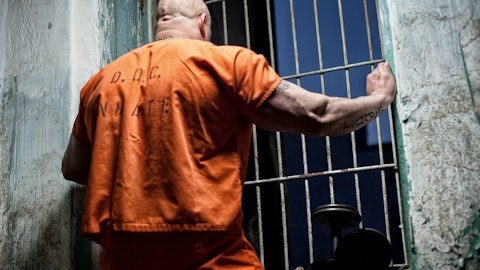Brendan McCarthy: And then secondly with the ISAP capacity, just wondering, just curious if you can maybe quantify, just what kind of the ramp up process might look like looking into maybe 2024 if funding levels were to increase. Are you able to quantify what the timing of a potential ramp-up to a significantly more number of participants would look like?
George Zoley: It’s hard to answer that question. As Wayne said, we have the ability to scale up fairly quickly and how do you do that? You’d have to add more staff at our Boulder, Colorado facility and probably at various locations around the country. We have a very large countrywide footprint of almost a 100 different locations. But the electronic devices are made in our Boulder facility and we are capable of ramping up fairly quickly. We have the supplies. And I think ICE is aware of our capabilities and like on the detention side, they stay in touch with us as to what those capabilities are relative to the different kinds of devices we have from the ankle monitors to watches, we have 150,000 phones available at the facility and there’s different programs that can be applied using those different technologies, and that can scale up to much larger populations at a discounted cost for less frequent monitoring.
Jose Gordo: I’d add, our in -country offices have a lot of personnel who are dedicated to non-electronic services such as case management, office visits, home visits, all of that can be scaled up as needed. A great deal will depend, however, on the government’s ability to scale up and repurpose folks that are working at the border. The ICE officials that work closely with them, all of that would have to be focused on the traffic that’s coming in and the processing and enrollment of persons who are coming across the border into one or more programs based on the administration’s policies and priorities, which is to get back to Brian’s comments, it’s very lumpy.
Brian Evans: It can be lumpy.
Operator: The next question comes from Greg Gibas with Northland Securities. Please go ahead.
Greg Gibas: I wanted to I guess first just ask, if there’s any significant or maybe notable contracts up for renewal in the near-term or upcoming quarters?
George Zoley: Not this year, no.
Greg Gibas: And then as it relates to the delevering good progress there in terms of net debt reduction. You mentioned the two additional facilities, I think it was the New Jersey facility, the sale of that kind of accelerated the delevering. You talked about two additional facilities. And curious if you could share maybe interest levels or timing of those. Would those be like a Q4 event, or do you have any sense of when those asset sales would happen?
Brian Evans: No, I think there’s facilities that we’ve got targeted and we have brokers active trying to place those properties, but right now we don’t have any contracts on those properties.
Greg Gibas: And I guess just lastly, as it relates to you marketing the idle facilities, which I believe count for like 9,000 beds, how do you kind of weigh — like, when I think about you hitting these net occupancy levels and obviously increased margins, as occupancies increase after that, how do you kind of weigh reactivation of idle facilities versus just increasing those occupancy levels at existing facilities? Is that up to the customer, or is — just curious how you’re kind of weighing those two things?
George Zoley: It’s really up to the customer and where their priorities are on a regional basis. We have a lot of facilities, obviously, in the southern belt states, Texas, Louisiana, et cetera. But we do have other locations in the north, in the northeast that are prime locations. And what makes it attractive for those locations is that a lot of county jails that have previously provided occupancy and services for DHS and ICE have been pulling out of the business, so to speak, because of either financial or political reasons. And therefore, our particular facilities, which are generally much more modern and it more closely meets the most recent updated ICE standards are particularly attractive, in the long haul we think will be utilized, eventually.
Operator: The next question comes from Kirk Ludtke with Imperial Capital. Please go ahead.
Kirk Ludtke: I just have a couple follow-ups. With respect to ISAP, how many people do you think would be monitored under the House proposal?
George Zoley: Well, monitor is a generous word. It can cover a lot of topics. In terms of electronic monitoring, the numbers were substantially higher a year ago. They could accommodate that again. They could be in other areas. They could, for example, ask for more folks to be in social service oversight, case management. We mentioned the Watch is a new program that’s been under pilot with ISAP. So, there are a lot of different ways that they could accommodate growth in their numbers, should that be the direction they take. But the policy remains to be set and more importantly, the budget remains to be set.
Jose Gordo: And there’s different programs that can be activated on a less — on a descending less intensive basis. For example, some people could be monitored every day, every hour of every day, some people weekly, some people monthly, some people biyearly. It’s all those tools are available to ICE in deciding, in addition to direct case management and support services. What level of periodic monitoring is appropriate for that particular person or group of persons.
George Zoley: Program can be opted.
Kirk Ludtke: Is this something that’s been contemplated in the past or is this a kind of a new thing?
George Zoley: The different programs we were just referring to that is presently available to ICE. So they know about our capabilities in performing these different levels of intensity of services and we have pricing for those different levels of services. It’s just a matter of, I guess, funding and priorities, where they want to put their money and what’s most important at that particular time.
Jose Gordo: I think the element that’s new in that house proposal and remains to be seen what will be part of the final legislation is the GPS monitoring of all cases until they are decided. So, if that were to actually be implemented, it could in theory capture most of the legal case docket. But it’s just a proposal at this time.
Kirk Ludtke: Got it. It’s interesting. And then just shifting gears quickly, we do appreciate the time. On the state level, have you been able to increase pricing on your state contracts? I know typically those state contracts get repriced, I believe, on July 1st. Did any of that take place for you?




